The aim is to set up a list of tools that can be used with Vastai. The tools are free to use, modify and distribute. If you find this helpful and would like to donate, you can send your donations to the following wallets.
BTC 15qkQSYXP2BvpqJkbj2qsNFb6nd7FyVcou
XMR 897VkA8sG6gh7yvrKrtvWningikPteojfSgGff3JAUs3cu7jxPDjhiAZRdcQSYPE2VGFVHAdirHqRZEpZsWyPiNK6XPQKAg
RVN RSgWs9Co8nQeyPqQAAqHkHhc5ykXyoMDUp
USDT(ETH ERC20) 0xa5955cf9fe7af53bcaa1d2404e2b17a1f28aac4f
Paypal PayPal.Me/cryptolabsZA
Host install guide for vast
Self-verification test
Speedtest-cli fix for vast
Analytics dashboard
Monitor your Nvidia 3000/4000 Core, GPU Hotspot and Vram temps
nvml-error-when-using-ubuntu-22-and-24
Remove Pressitent red error messages
Memory oc
OC monitor
Stress testing GPUs on vast with Python benchmark of RTX3090's
Telegram-Vast-Uptime-Bot
Auto update the price for host listing based on mining profits
Background job or idle job for vast
Setting fan speeds if you have a headless system
Remove unattended-upgrades package
How to update a host
How to move your vast docker driver to another drive
Backup varlibdocker to another machine on your network
Connecting to running instance with VNC to see applications GUI
Setting up 3D accelerated desktop in web browser on vastai
Useful commands
How to set up a docker registry for the systems on your network
#Start with a clean install of ubuntu 22.04.x HWE Kernal server. Just add openssh.
sudo apt update && sudo apt upgrade -y && sudo apt dist-upgrade -y && sudo apt install update-manager-core -y
#if you did not install HWE kernal do the following
sudo apt install --install-recommends linux-generic-hwe-22.04 -y
sudo reboot
#install the drivers.
sudo apt install build-essential -y
sudo add-apt-repository ppa:graphics-drivers/ppa -y
sudo apt update
# to search for available NVIDIA drivers: use this command
sudo apt search nvidia-driver | grep nvidia-driver | sort -r
sudo apt install nvidia-driver-560 -y # assuming the latest is 560
#Remove unattended-upgrades Package so that the dirver don't upgrade when you have clients
sudo apt purge --auto-remove unattended-upgrades -y
sudo systemctl disable apt-daily-upgrade.timer
sudo systemctl mask apt-daily-upgrade.service
sudo systemctl disable apt-daily.timer
sudo systemctl mask apt-daily.service
# This is needed to remove xserver and genome if you started with ubunut desktop. clients can't run a desktop gui in an continer wothout if you have a xserver.
bash -c 'sudo apt-get update; sudo apt-get -y upgrade; sudo apt-get install -y libgtk-3-0; sudo apt-get install -y xinit; sudo apt-get install -y xserver-xorg-core; sudo apt-get remove -y gnome-shell; sudo update-grub; sudo nvidia-xconfig -a --cool-bits=28 --allow-empty-initial-configuration --enable-all-gpus'
#if Ubuntu is installed to a SSD and you plan to have the vast client data stored on a nvme follow the below instructions.
#WARRNING IF YOUR OS IS ON /dev/nvme0n1 IT WILL BE WIPED. CHECK TWICE change this device to the intended device name that you pan to use.
# this is one command that will create the xfs partion and write it to the disk /dev/nvme0n1.
echo -e "nnnnnnnwn" | sudo cfdisk /dev/nvme0n1 && sudo mkfs.xfs /dev/nvme0n1p1
sudo mkdir /var/lib/docker
#I added discard so that the ssd is trimeds by ubunut and nofail if there is some problem with the drive the system will still boot.
sudo bash -c 'uuid=$(sudo xfs_admin -lu /dev/nvme0n1p1 | sed -n "2p" | awk "{print $NF}"); echo "UUID=$uuid /var/lib/docker/ xfs rw,auto,pquota,discard,nofail 0 0" >> /etc/fstab'
sudo mount -a
# check that /dev/nvme0n1p1 is mounted to /var/lib/docker/
df -h
#this will enable Persistence mode on reboot so that the gpus can go to idle power when not used
sudo bash -c '(crontab -l; echo "@reboot nvidia-smi -pm 1" ) | crontab -'
#run the install command for vast
sudo apt install python3 -y
sudo wget https://console.vast.ai/install -O install; sudo python3 install YourKey; history -d $((HISTCMD-1));
GRUB_CMDLINE_LINUX="amd_iommu=on nvidia_drm.modeset=0 systemd.unified_cgroup_hierarchy=false"
#only run this command if you plan to support VM's on your machines. read vast guide to understand more https://vast.ai/docs/hosting/vms
sudo bash -c 'sed -i "/^GRUB_CMDLINE_LINUX=""/s/""/"amd_iommu=on nvidia_drm.modeset=0"/" /etc/default/grub && update-grub'
update-grub
#if you get nvml error then run this
sudo wget https://raw.githubusercontent.com/jjziets/vasttools/main/nvml_fix.py
sudo python3 nvml_fix.py
sudo reboot
#follow the Configure Networking instructions as per https://console.vast.ai/host/setup
#test the ports with running sudo nc -l -p port on the host machine and use https://portchecker.co to verify
sudo bash -c 'echo "40000-40019" > /var/lib/vastai_kaalia/host_port_range'
sudo reboot
#After reboot, check that the drive is mounted to /var/lib/docker and that your systems show up on the vast dashboard.
df -h # look for /var/lib/docker mount
sudo systemctl status vastai
sudo systemctl status dockerYou can run the following test to ensure your new machine will be on the shortlist for verification testing. If you pass, there is a high chance that your machine will be eligible for verification. Take not that your router need to allow loopback if you run this from a machine on the same network as the machine you want to test. If you do not know how to enable loopback it will be better to run this on a VM from a cloud provider or with mobile connection to your pc.
The autoverify_machineid.sh script is part of a suite of tools designed to automate the testing of machines on the Vast.ai marketplace. This script specifically tests a single machine to determine if it meets the minimum requirements necessary for further verification.
Before you start using ./autoverify_machineid.sh, ensure you have the following:
Vast.ai Command Line Interface (vastcli): This tool is used to interact with the Vast.ai platform.
Vast.ai Listing: The machine should be listed on the vast marketplace.
Ubuntu OS: The scripts are designed to run on Ubununt 20.04 or newer.
Download and Setup vastcli:
Download the Vast.ai CLI tool using the following command:
wget https://raw.githubusercontent.com/vast-ai/vast-python/master/vast.py -O vast chmod +x vast
Set your Vast.ai API key:
./vast set api-key 6189d1be9f15ad2dced0ac4e3dfd1f648aeb484d592e83d13aaf50aee2d24c07
Download autoverify_machineid.sh:
Use wget to download autoverify_machineid.sh to your local machine:
wget https://github.com/jjziets/VastVerification/releases/download/0.4-beta/autoverify_machineid.sh
Make Scripts Executable:
Change the permissions of the main scripts to make them executable:
chmod +x autoverify_machineid.sh
Dependencies
apt update apt install bc jq
Run the the following to install the required packages
./autoverify_machineid.shCheck Machine Requirements:
The ./autoverify_machineid.sh script is designed to test if a single machine meets the minimum requirements for verification. This is useful for hosts who want to verify their own machines.
To test a specific machine by its machine_id, use the following command:
./autoverify_machineid.sh <machine_id>
Replace <machine_id> with the actual ID of the machine you want to test.
To Ignore Requirements Check:
./autoverify_machineid.sh --ignore-requirements <machine_id>
This command runs the tests for the machine, regardless of whether it meets the minimum requirements.
Progress and Results Logging:
The script logs the progress and results of the tests.
Successful results and machines that pass the requirements will be logged in Pass_testresults.log.
Machines that do not meet the requirements or encounter errors during testing will be logged in Error_testresults.log.
Understanding the Logs:
Pass_testresults.log: This file contains entries for machines that successfully passed all tests.
Error_testresults.log: This file contains entries for machines that failed to meet the minimum requirements or encountered errors during testing.
Here’s how you can run the autoverify_machineid.sh script to test a machine with machine_id 10921:
./autoverify_machineid.sh 10921
API Key Issues: Ensure your API key is correctly set using ./vast set api-key <your-api-key>.
Permission Denied: If you encounter permission issues, make sure the script files have executable permissions (chmod +x <script_name>).
Connection Issues: Verify your network connection and ensure the Vast.ai CLI can communicate with the Vast.ai servers.
By following this guide, you will be able to use the ./autoverify_machineid.sh script to test individual machines on the Vast.ai marketplace. This process helps ensure that machines meet the required specifications for GPU and system performance, making them candidates for further verification and use in the marketplace.
If you are having problems with your machine not showing its upload and download speed correctly.
first check if there is a problem by forcing the speedtest to run
cd /var/lib/vastai_kaalia ./send_mach_info.py --speedtest
output should look like this
2024-10-03 08:50:04.587469
os version
running df
checking errors
nvidia-smi
560035003
/usr/bin/fio
checking speedtest
/usr/bin/speedtest
speedtest
running speedtest on random server id 19897
{"type":"result","timestamp":"2024-10-03T08:50:24Z","ping":{"jitter":0.243,"latency":21.723,"low":21.526,"high":22.047},"download":{"bandwidth":116386091,"bytes":1010581968,"elapsed":8806,"latency":{"iqm":22.562,"low":20.999,"high":296.975,"jitter":3.976}},"upload":{"bandwidth":116439919,"bytes":980885877,"elapsed":8508,"latency":{"iqm":36.457,"low":6.852,"high":349.495,"jitter":34.704}},"packetLoss":0,"isp":"Vox Telecom","interface":{"internalIp":"192.168.1.101","name":"bond0","macAddr":"F2:6A:67:0C:85:8B","isVpn":false,"externalIp":"41.193.204.66"},"server":{"id":19897,"host":"speedtest.wibernet.co.za","port":8080,"name":"Wibernet","location":"Cape Town","country":"South Africa","ip":"102.165.64.110"},"result":{"id":"18bb02e4-466d-43dd-b1fc-3f106319a9f6","url":"https://www.speedtest.net/result/c/18bb02e4-466d-43dd-b1fc-3f106319a9f6","persisted":true}}
....If the above speedtest does not work, you can try to install an alternative newer one. Due to the newer speed test output not having the same format, a script will translate it so that vast can use the new speed test. All the commands combined
bash -c "sudo apt-get install curl -y && sudo curl -s https://packagecloud.io/install/repositories/ookla/speedtest-cli/script.deb.sh | sudo bash && sudo apt-get install speedtest -y && sudo apt install python3 -y && cd /var/lib/vastai_kaalia/latest && sudo mv speedtest-cli speedtest-cli.old && sudo wget -O speedtest-cli https://raw.githubusercontent.com/jjziets/vasttools/main/speedtest-cli.py && sudo chmod +x speedtest-cli"
or step by step
sudo apt-get install curl sudo curl -s https://packagecloud.io/install/repositories/ookla/speedtest-cli/script.deb.sh | sudo bash sudo apt-get install speedtest -y sudo apt install python3 -y cd /var/lib/vastai_kaalia/latest sudo mv speedtest-cli speedtest-cli.old sudo wget -O speedtest-cli https://raw.githubusercontent.com/jjziets/vasttools/main/speedtest-cli.py sudo chmod +x speedtest-cli
This updated your speed test to the newer one and translated the output so that Vast Demon can use it. If you now get slower speeds, follow this
## If migrating from prior bintray install instructions please first... # sudo rm /etc/apt/sources.list.d/speedtest.list # sudo apt-get update # sudo apt-get remove speedtest -y ## Other non-official binaries will conflict with Speedtest CLI # Example how to remove using apt-get # sudo apt-get remove speedtest-cli sudo apt-get install curl curl -s https://packagecloud.io/install/repositories/ookla/speedtest-cli/script.deb.sh | sudo bash sudo apt-get install speedtest
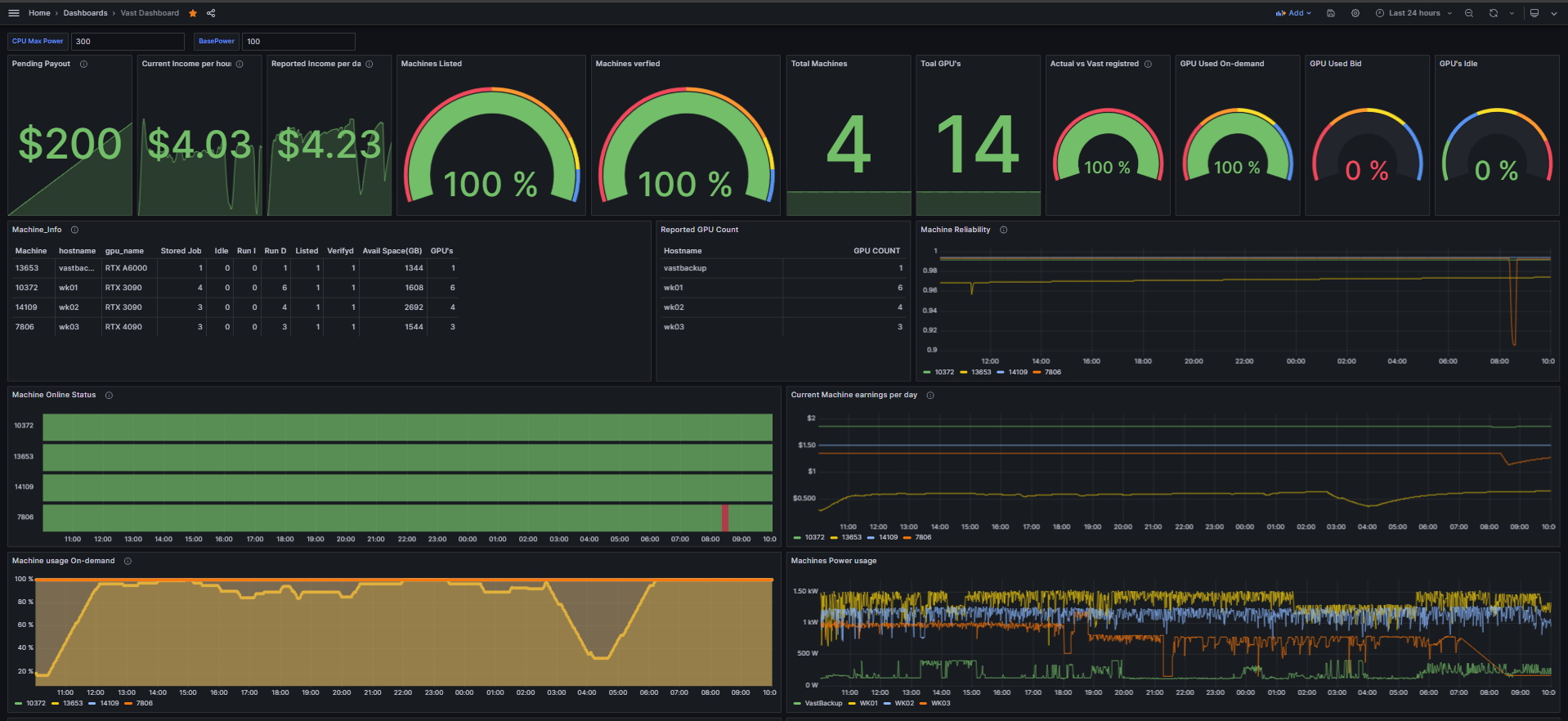
Prometheus Grafana monitoring systems, send alerts and track all metrics regarding your equipment and also track earnings and rentals. https://github.com/jjziets/DCMontoring
run the script below if you have a problem with vast installer on 22,24 and nvml error this script is based on Bo26fhmC5M so credit go to him
sudo wget https://raw.githubusercontent.com/jjziets/vasttools/main/nvml_fix.py sudo python nvml_fix.py
if you have a red error message on your machine that you have confirmed has been addressed. It might help to delete /var/lib/vastai_kaalia/kaalia.log and reboot
sudo rm /var/lib/vastai_kaalia/kaalia.log sudo systemctl restart vastai
If you do not want to setup the Analytics dashboard and you just want to see all the Temps on your gpu then you can use the below tool
sudo wget https://github.com/jjziets/gddr6_temps/raw/master/nvml_direct_access sudo chmod +x nvml_direct_access sudo ./nvml_direct_access
set the OC of the RTX 3090 It requires the following
on the host run the following command:
sudo apt-get install libgtk-3-0 && sudo apt-get install xinit && sudo apt-get install xserver-xorg-core && sudo update-grub && sudo nvidia-xconfig -a --cool-bits=28 --allow-empty-initial-configuration --enable-all-gpus wget https://raw.githubusercontent.com/jjziets/vasttools/main/set_mem.sh sudo chmod +x set_mem.sh sudo ./set_mem.sh 2000 # this will set the memory OC to +1000mhs on all the gpus. You can use 3000 on some gpu's which will give 1500mhs OC.
setup the monitoring program that will change the memory oc based on what programe is running. it designed for RTX3090's and targets ethminer at this stage. It requires both set_mem.sh and ocmonitor.sh to run in the root.
wget https://raw.githubusercontent.com/jjziets/vasttools/main/ocminitor.sh sudo chmod +x ocminitor.sh sudo ./ocminitor.sh # I suggest running this in tmux or screen so that when you close the ssh connetion. It looks for ethminer and if it finds it it will set the oc based on your choice. you can also set powerlimits with nvidia-smi -pl 350
To load at reboot use the crontab below
sudo (crontab -l; echo "@reboot screen -dmS ocmonitor /home/jzietsman/ocminitor.sh") | crontab - #replace the user with your user
Mining does not stress your system the same as python work loads do, so this is a good test to run as well.
First, set a maintenance window, and then once you have no clients running, you can do the stress testing.
https://github.com/jjziets/pytorch-benchmark-volta
a full suite of stress tests can be found docker image jjziets/vastai-benchmarks:latest in folder /app/
stress-ng - CPU stress stress-ng - Drive stress stress-ng - Memory stress sysbench - Memory latency and speed benchmark dd - Drive speed benchmark Hashcat - Benchmark bandwithTest - GPU bandwith benchmark pytorch - Pytorch DL benchmark
#test or bash interface
sudo docker run --shm-size 1G --rm -it --gpus all jjziets/vastai-benchmarks /bin/bash apt update && apt upgrade -y ./benchmark.sh
#Run using default settings Results are saved to ./output.
sudo docker run -v ${PWD}/output:/app/output --shm-size 1G --rm -it --gpus all jjziets/vastai-benchmarks
Run with params SLEEP_TIME/BENCH_TIME
sudo docker run -v ${PWD}/output:/app/output --shm-size 1G --rm -it -e SLEEP_TIME=2 -e BENCH_TIME=2 --gpus all jjziets/vastai-benchmarksYou can also do a GPU burn test.
sudo docker run --gpus all --rm oguzpastirmaci/gpu-burn <test duration in seconds>
If you want to run it for one GPU, run the command below, replacing the x with the GPU number starting at 0.
sudo docker run --gpus '"device=x"' --rm oguzpastirmaci/gpu-burn <test duration in seconds>
*based on leona / vast.ai-tools
This is a set of scripts for monitoring machine crashes. Run the client on your vast machine and the server on a remote one. You get notifications on Telegram if no heartbeats are sent within the timeout (default 12 seconds). https://github.com/jjziets/Telegram-Vast-Uptime-Bot
based on RTX 3090 120Mhs for eth. it sets the price of my 2 host. it works with a custom Vast-cli which can be found here https://github.com/jjziets/vast-python/blob/master/vast.py The manager is here https://github.com/jjziets/vasttools/blob/main/setprice.sh
This should be run on a vps not on a host. do not expose your Vast API keys by using it on the host.
wget https://github.com/jjziets/vast-python/blob/master/vast.py sudo chmod +x vast.py ./vast.py set api-key UseYourVasset wget https://github.com/jjziets/vasttools/blob/main/setprice.sh sudo chmod +x setprice.sh
The best way to manage your idle job is via the vast cli. To my knowledge, the GUI set job is broken. So to set an idle job follow the following steps. You will need to download the vast cli and run the following commands. The idea is to rent yourself as an interruptible job. The vast cli allows you to set one idle job for all the GPUs or one GPU per instance. You can also set the SSH connection method or any other method. Go to https://cloud.vast.ai/cli/ and install your cli flavour.
setup your account key so that you can use the vast cli. you get this key from your account page.
./vast set api-key API_KEY
You can use my SetIdleJob.py scrip to setup your idle job based on the minimum price set on your machines.
wget https://raw.githubusercontent.com/jjziets/vasttools/main/SetIdleJob.py
Here is an example of how I mine to nicehash
python3 SetIdleJob.py --args 'env | grep _ >> /etc/environment; echo "starting up"; apt -y update; apt -y install wget; apt -y install libjansson4; apt -y install xz-utils; wget https://github.com/develsoftware/GMinerRelease/releases/download/3.44/gminer_3_44_linux64.tar.xz; tar -xvf gminer_3_44_linux64.tar.xz; while true; do ./miner --algo kawpow --server stratum+tcp://kawpow.auto.nicehash.com:9200 --user 3LNHVWvUEufL1AYcKaohxZK2P58iBHdbVH.${VAST_CONTAINERLABEL:2}; done'Or the full command if you don't want to use the defaults
python3 SetIdleJob.py --image nvidia/cuda:12.4.1-runtime-ubuntu22.04 --disk 16 --args 'env | grep _ >> /etc/environment; echo "starting up"; apt -y update; apt -y install wget; apt -y install libjansson4; apt -y install xz-utils; wget https://github.com/develsoftware/GMinerRelease/releases/download/3.44/gminer_3_44_linux64.tar.xz; tar -xvf gminer_3_44_linux64.tar.xz; while true; do ./miner --algo kawpow --server stratum+tcp://kawpow.auto.nicehash.com:9200 --user 3LNHVWvUEufL1AYcKaohxZK2P58iBHdbVH.${VAST_CONTAINERLABEL:2}; done' --api-key b149b011a1481cd852b7a1cf1ccc9248a5182431b23f9410c1537fca063a68b1Trouble shoot your bash -c command by using the logs on the instance page

Alternatively, you can rent yourself with the following command and then log in and load what you want to run. Make sure to add your process to onstart.sh to rent your self first find your machine with he machine id
./vast search offers "machine_id=14109 verified=any gpu_frac=1 " # gpu_frac=1 will give you the instance with all the gpus.
or
./vast search offers -i "machine_id=14109 verified=any min_bid>0.1 num_gpus=1" # it will give you the instance with one GPU
Once you have the offe_id. and in this case, the search with a -i switch will give you an interruptible instance_id
Let's assume you want to mine with lolminer
./vast create instance 9554646 --price 0.2 --image nvidia/cuda:12.0.1-devel-ubuntu20.04 --env '-p 22:22' --onstart-cmd 'bash -c "apt -y update; apt -y install wget; apt -y install libjansson4; apt -y install xz-utils; wget https://github.com/Lolliedieb/lolMiner-releases/releases/download/1.77b/lolMiner_v1.77b_Lin64.tar.gz; tar -xf lolMiner_v1.77b_Lin64.tar.gz -C ./; cd 1.77b; ./lolMiner --algo ETCHASH --pool etc.2miners.com:1010 --user 0xYour_Wallet_Goes_Here.VASTtest"' --ssh --direct --disk 100
it will start the instance on price 0.2.
./vast show instances # will give you the list of instance ./vast change bid 9554646 --price 0.3 # This will change the price to 0.3 for the instance
Here is a repo with two programs and a few scripts that you can use to manage your fans https://github.com/jjziets/GPU_FAN_OC_Manager/tree/main
bash -c "wget https://github.com/jjziets/GPU_FAN_OC_Manager/raw/main/set_fan_curve; chmod +x set_fan_curve; CURRENT_PATH=$(pwd); nohup bash -c "while true; do $CURRENT_PATH/set_fan_curve 65; sleep 1; done" > output.txt & (crontab -l; echo "@reboot screen -dmS gpuManger bash -c 'while true; do $CURRENT_PATH/set_fan_curve 65; sleep 1; done'") | crontab -"
If your system updates while vast is running or even worse when a client is renting you then you might get de-verified or banned. It's advised to only update when the system is unrented and delisted. best would be to set an end date of your listing and conduct updates and upgrades at that stage. to stop unattended-upgrades run the following commands.
sudo apt purge --auto-remove unattended-upgrades -y sudo systemctl disable apt-daily-upgrade.timer sudo systemctl mask apt-daily-upgrade.service sudo systemctl disable apt-daily.timer sudo systemctl mask apt-daily.service
When the system is idle and delisted run the following commands. vast demon and docker services are stopped. It is also a good idea to upgrade Nvidia drivers like this. If you don't and the upgrades brakes a package you might get de-verifyed or even banned from vast.
bash -c ' sudo systemctl stop vastai; sudo systemctl stop docker.socket; sudo systemctl stop docker; sudo apt update; sudo apt upgrade -y; sudo systemctl start docker.socket ; sudo systemctl start docker; sudo systemctl start vastai'
This guide illustrates how to back up vastai Docker data from an existing drive and transfer it to a new drive . in this case a raid driver /dev/md0
No clients are running and that you are un listed from the vast market.
Docker data exists on the current drive.
Install required tools:
sudo apt install pv pixz
Stop and disable relevant services:
sudo systemctl stop vastai docker.socket docker sudo systemctl disable vastai docker.socket docker
Backup the Docker directory:
Create a compressed backup of the /var/lib/docker directory. Ensure there's enough space on the OS drive for this backup. Or move the data to backup server. see https://github.com/jjziets/vasttools/blob/main/README.md#backup-varlibdocker-to-another-machine-on-your-network
sudo tar -c -I 'pixz -k -1' -f ./docker.tar.pixz /var/lib/docker | pv #you can change ./ to a destination directory
Note: pixz utilizes multiple cores for faster compression.
Unmount the Docker directory: If you're planning to shut down and install a new drive:
sudo umount /var/lib/docker
Update /etc/fstab:
Disable auto-mounting of the current Docker directory at startup to prevent boot issues:
sudo nano /etc/fstab
Comment out the line associated with /var/lib/docker by adding a # at the start of the line.
Partition the New Drive:
(Adjust the device name based on your system. The guide uses /dev/md0 for RAID and /dev/nvme0n1 for NVMe drives as examples.)
sudo cfdisk /dev/md0
Format the new partition with XFS:
sudo mkfs.xfs -f /dev/md0p1
Retrieve the UUID:
You'll need the UUID for updating /etc/fstab.
sudo xfs_admin -lu /dev/md0p1
Update /etc/fstab with the New Drive:
sudo nano /etc/fstab
Add the following line (replace the UUID with the one you retrieved):
UUID="YOUR_UUID_HERE" /var/lib/docker xfs rw,auto,pquota,discard,nofail 0 0
Mount the new partition:
sudo mount -a
Confirm the mount:
df -h
Ensure /dev/md0p1 (or the appropriate device name) is mounted to /var/lib/docker.
Restore the Docker data: Navigate to the root directory:
cd /
Decompress and restore: Ensure to change the user to the relevent name
sudo cat /home/user/docker.tar.pixz | pv | sudo tar -x -I 'pixz -d -k'
Enable services:
sudo systemctl enable vastai docker.socket docker
Reboot:
sudo reboot
Check if the desired drive is mounted to /var/lib/docker and ensure vastai is operational.
/var/lib/docker to Another Machine on Your NetworkIf you're looking to migrate your Docker setup to another machine, whether for replacing the drive or setting up a RAID, follow this guide. For this example, we'll assume the backup server's IP address is 192.168.1.100.
Temporarily Enable Root SSH Login: It's essential to ensure uninterrupted SSH communication during the backup process, especially when transferring large files like compressed Docker data. a. Open the SSH configuration:
sudo nano /etc/ssh/sshd_config
b. Locate and change the line:
PermitRootLogin no
to:
PermitRootLogin yes
c. Reload the SSH configuration:
sudo systemctl restart sshd
Generate an SSH Key and Transfer it to the Backup Server: a. Create the SSH key:
sudo ssh-keygen
b. Copy the SSH key to the backup server:
sudo ssh-copy-id -i ~/.ssh/id_rsa [email protected]
Disable Root Password Authentication: Ensure only the SSH key can be used for root login, enhancing security. a. Modify the SSH configuration:
sudo nano /etc/ssh/sshd_config
b. Change the line to:
PermitRootLogin prohibit-password
c. Reload the SSH configuration:
sudo systemctl restart sshd
Preparation for Backup: Before backing up, ensure relevant services are halted:
sudo systemctl stop docker.socket sudo systemctl stop docker sudo systemctl stop vastai sudo systemctl disable vastai sudo systemctl disable docker.socket sudo systemctl disable docker
Backup Procedure:
This procedure compresses the /var/lib/docker directory and transfers it to the backup server.
a. Switch to the root user and install necessary tools:
sudo su apt install pixz apt install pv
It mght be a good idea to run the backup command in tmux or screen so that if you lose ssh connecton the process will finish. b. Perform the backup:
tar -c -I 'pixz -k -0' -f - /var/lib/docker | pv | ssh [email protected] "cat > /mnt/backup/machine/docker.tar.pixz"
Restoring the Backup:
Make sure your new drive is mounted at /var/lib/docker.
a. Switch to the root user:
sudo su
b. Restore from the backup:
cd / ssh [email protected] "cat /mnt/backup/machine/docker.tar.pixz" | pv | sudo tar -x -I 'pixz -d -k'
Reactivate Services:
sudo systemctl enable vastai sudo systemctl enable docker.socket sudo systemctl enable docker sudo reboot
Post-reboot: Ensure your target drive is mounted to /var/lib/docker and that vastai is operational.
Using a instance with open ports If display is color depth is 16 not 16bit try another vnc viewer. TightVNC worked for me on windows
first tell vast to allow a port to be assinged. use the -p 8081:8081 and tick the direct command.
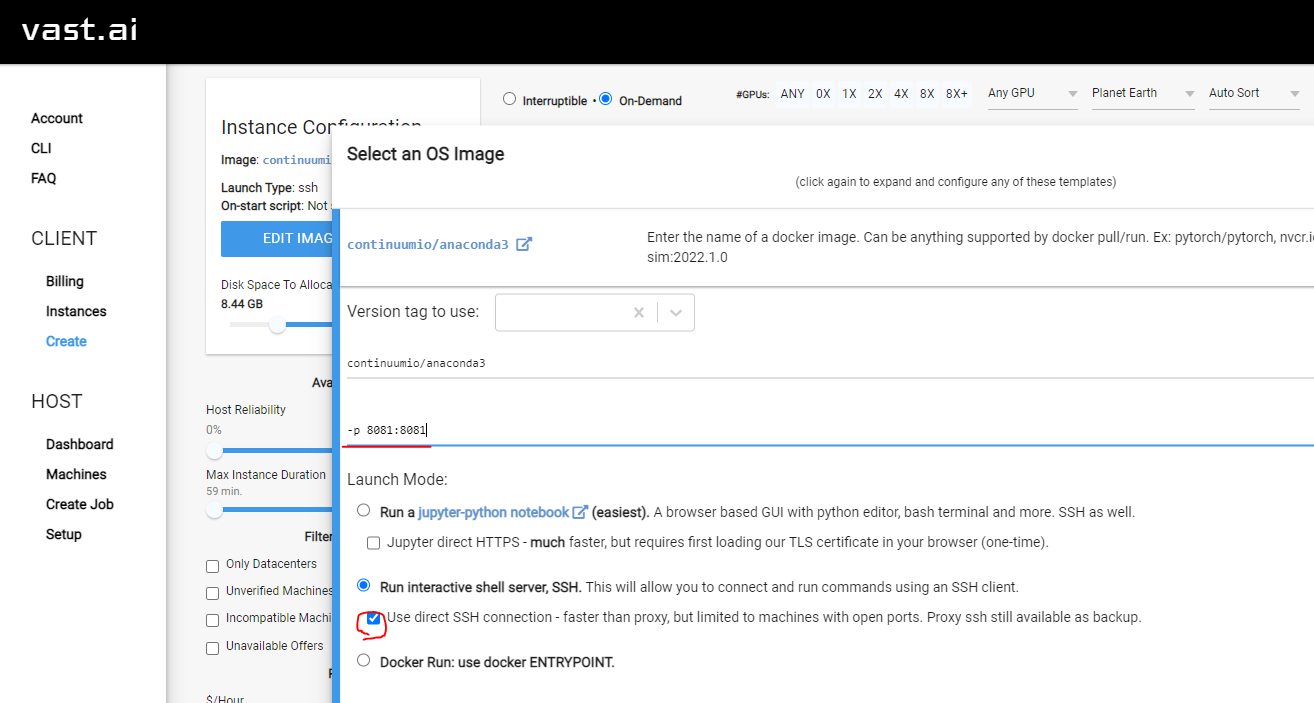
find a host with open ports and then rent it. preferbly on demand. go to the client instances page and wait for the connect button
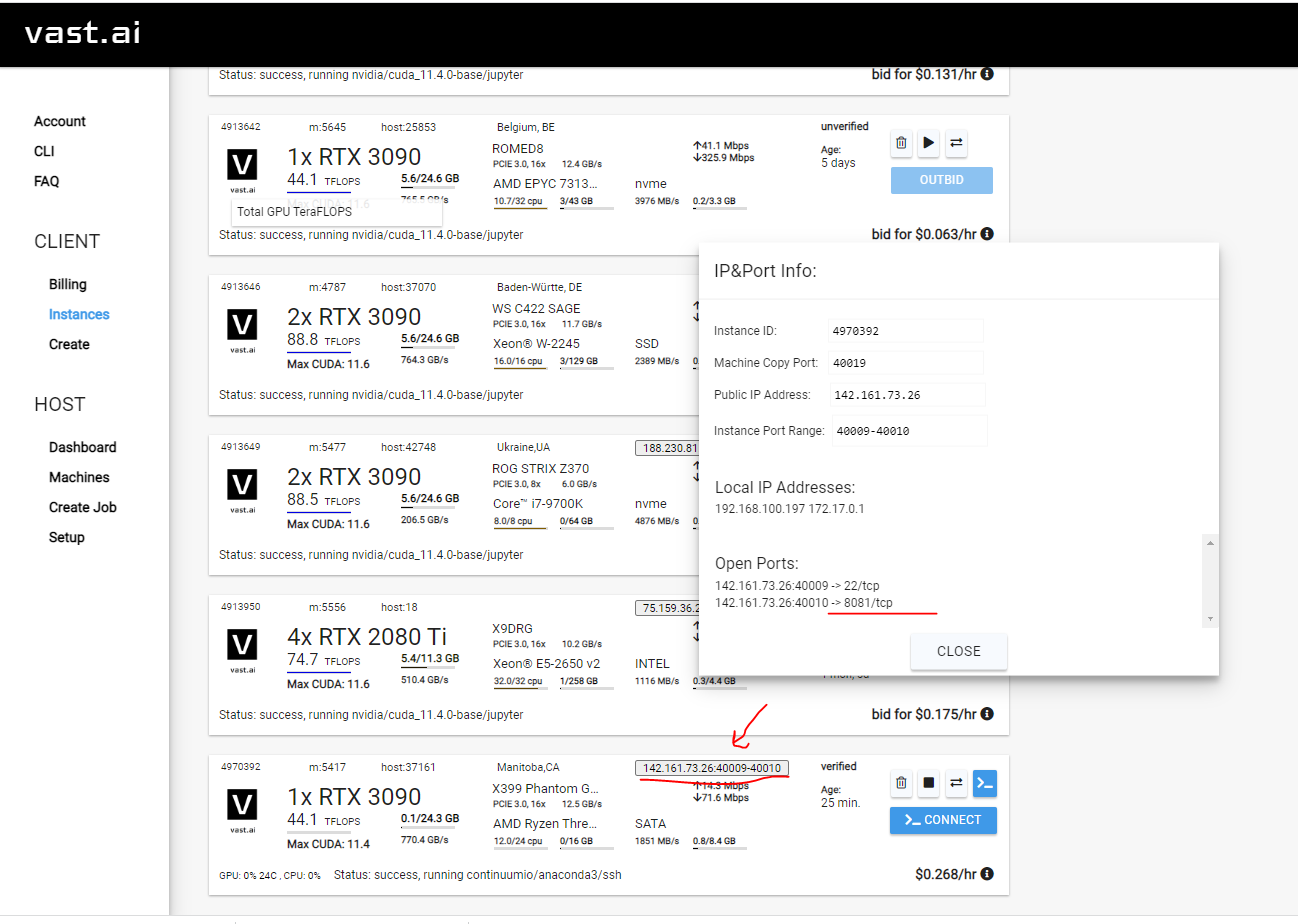
use ssh to connect to the instances.

run the below commands. the second part can be placed in the onstart.sh to run on restart
bash -c 'apt-get update; apt-get -y upgrade; apt-get install -y x11vnc; apt-get install -y xvfb; apt-get install -y firefox;apt-get install -y xfce4;apt-get install -y xfce4-goodies' export DISPLAY=:20 Xvfb :20 -screen 0 1920x1080x16 & x11vnc -passwd TestVNC -display :20 -N -forever -rfbport 8081 & startxfce4
To connect use the ip of the host and the port that was provided. In this case it is 400010
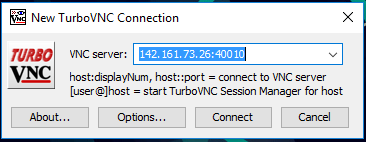

then enjoy the destkop. sadly this is not hardware accelarted. so no games will work
We will be using ghcr.io/ehfd/nvidia-glx-desktop:latest
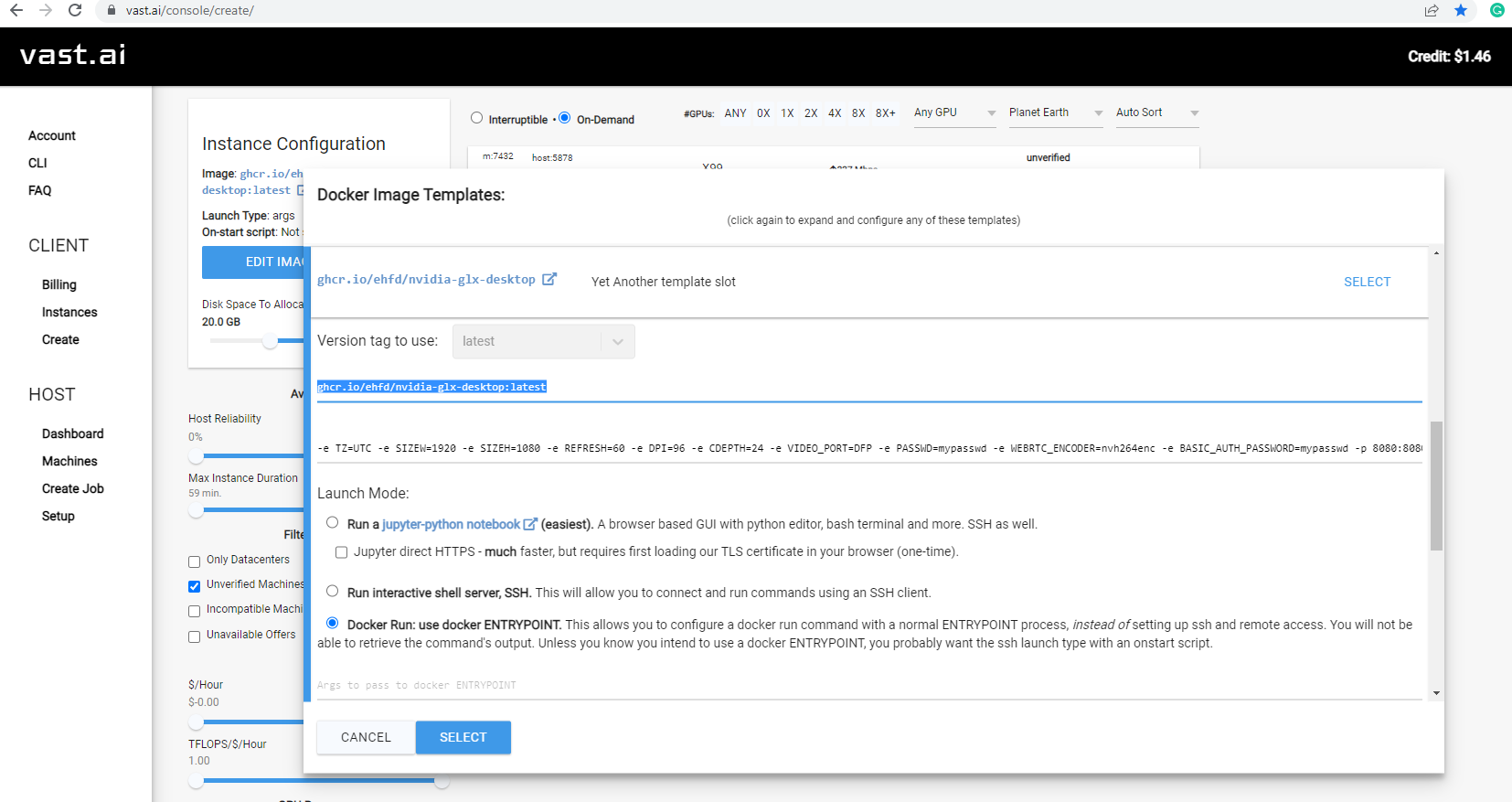
use this env paramters
-e TZ=UTC -e SIZEW=1920 -e SIZEH=1080 -e REFRESH=60 -e DPI=96 -e CDEPTH=24 -e VIDEO_PORT=DFP -e PASSWD=mypasswd -e WEBRTC_ENCODER=nvh264enc -e BASIC_AUTH_PASSWORD=mypasswd -p 8080:8080
find a system that has open ports

when done loading click open
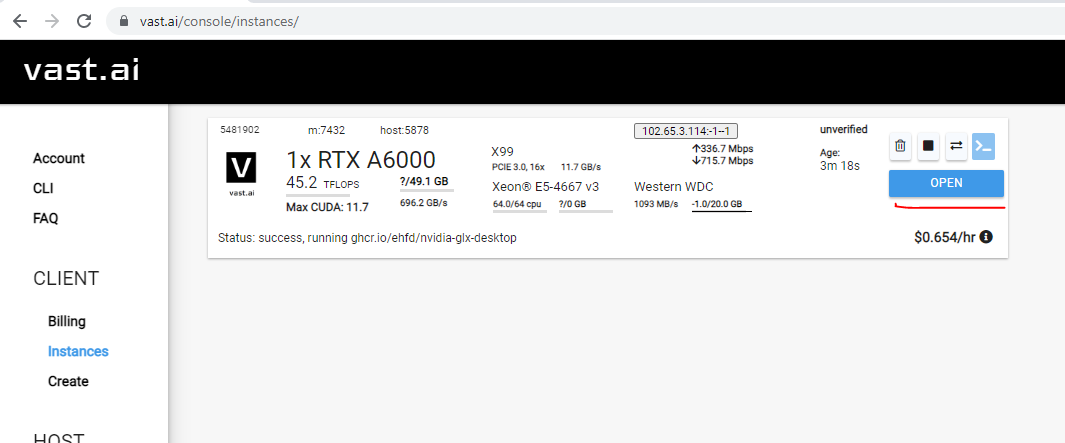
username is user and password is what you set mypasswd in this case
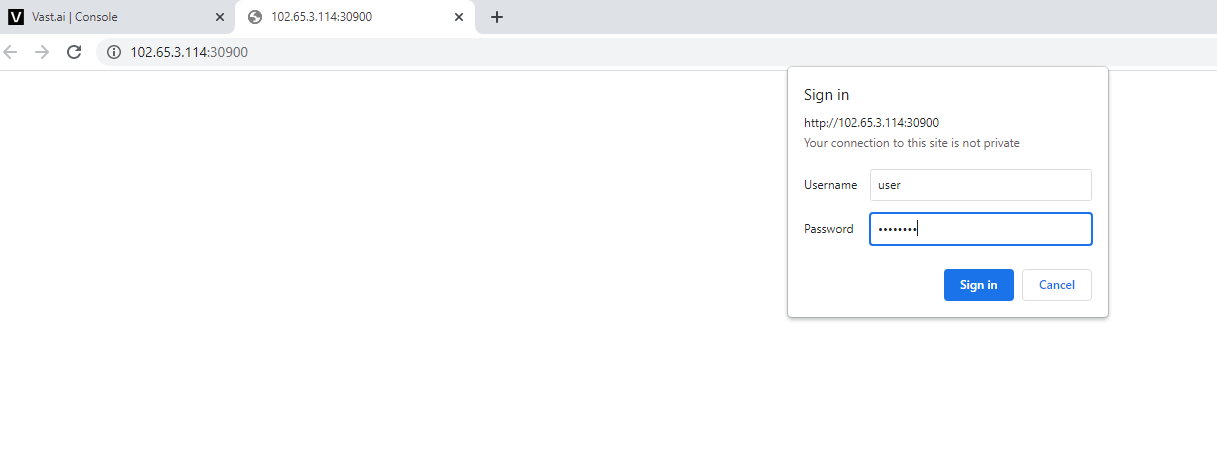
hit start
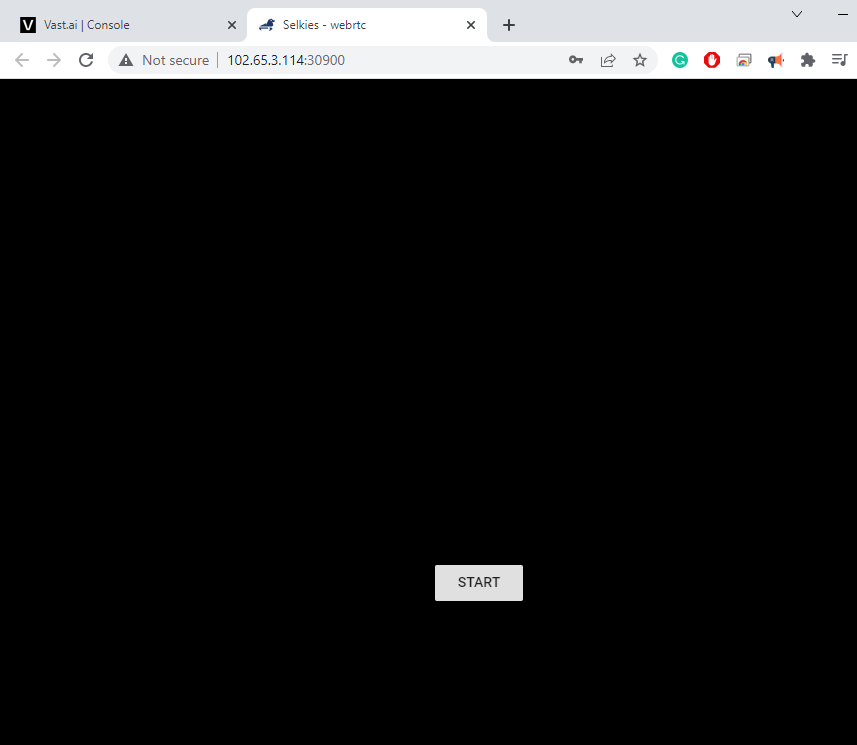
3D accelerated desktop environment in a web browser
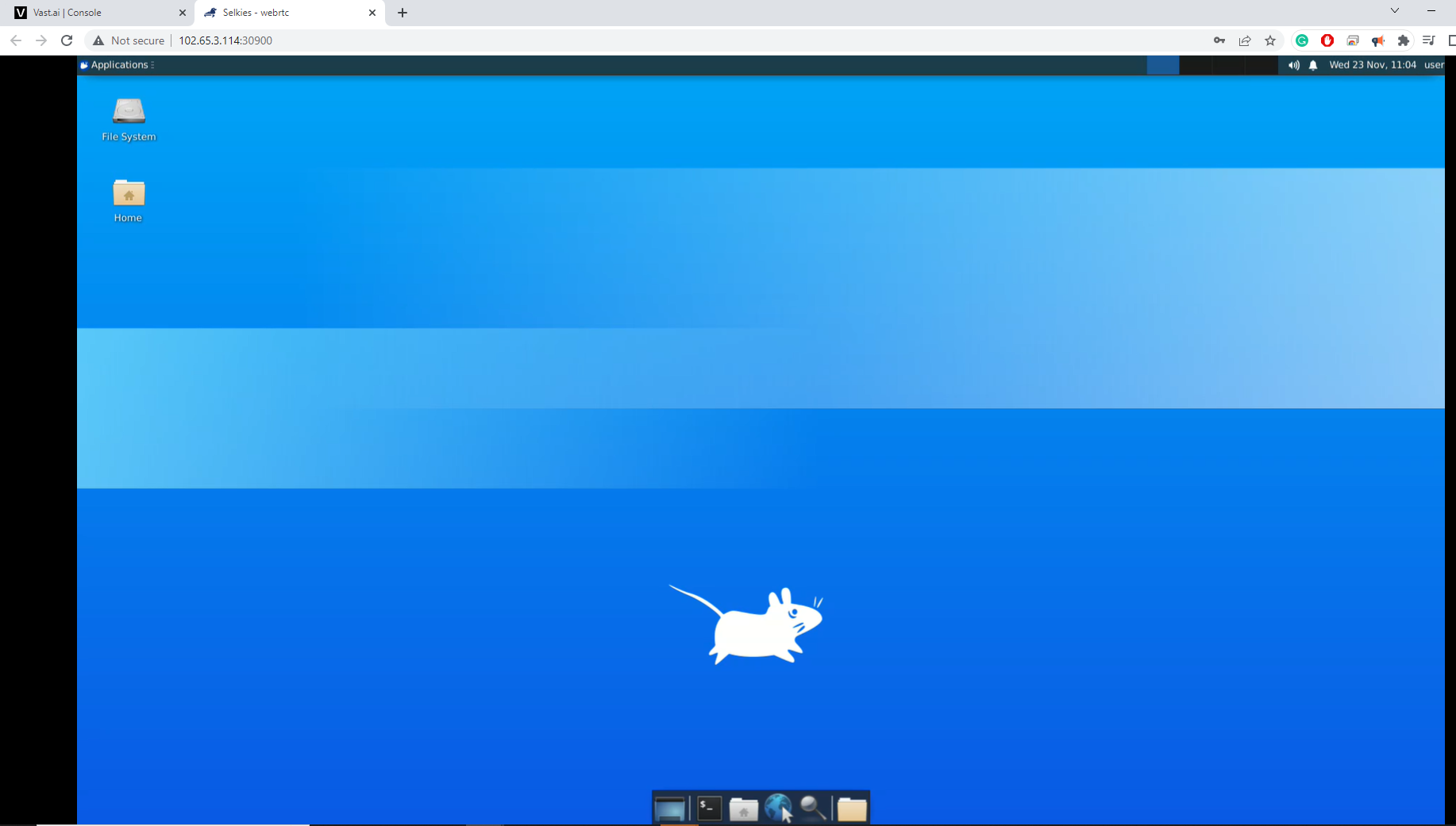
This will reduce the number of pull requests from your public IP. Docker is restricted to 100 pulls per 6h for unanonymous login, and it can speed up the startup time for your rentals. This guide provides instructions on how to set up a Docker registry server using Docker Compose, as well as configuring Docker clients to use this registry. Prerequisites Docker and Docker Compose are installed on the server that has a lot of fast storage on your local LAN. Docker is installed on all client machines.
Setting Up the Docker Registry Server install docker-compose if you have not already.
sudo su curl -L "https://github.com/docker/compose/releases/download/v2.24.4/docker-compose-$(uname -s)-$(uname -m)" -o /usr/local/bin/docker-compose chmod +x /usr/local/bin/docker-compose ln -s /usr/local/bin/docker-compose /usr/bin/docker-compose apt-get update && sudo apt-get install -y gettext-base
Create a docker-compose.yml file: Create a file named docker-compose.yml on your server with the following content:
version: '3' services: registry: restart: unless-stopped image: registry:2 ports: - 5000:5000 environment: - REGISTRY_PROXY_REMOTEURL=https://registry-1.docker.io - REGISTRY_STORAGE_DELETE_ENABLED="true" volumes: - data:/var/lib/registry volumes: data:
This configuration sets up a Docker registry server running on port 5000 and uses a volume named data for storage. Start the Docker Registry:
Run the following command in the directory where your docker-compose.yml file is located:
sudo docker-compose up -d
This command will star